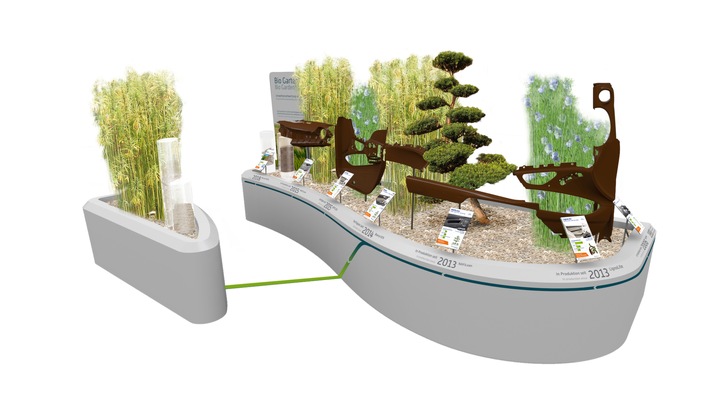
Faurecia has transformed a portion of its booth at the 2015 Frankfurt Motor Show into a living garden of biomaterials that the company is using to create lightweight door panels, instrument panels, trim and other non-visible vehicle interior parts.
In a free standing display, the Faurecia Bio Garden features an immersive experience in a living meadow of two meter high flax, industrial hemp and straw, as well as an Asian spruce tree. They all have been planted in soil and will continue to grow throughout the motor show.
One area of the display illustrates the results of Faurecia’s joint venture with Interval, a major French agricultural cooperative, to form Automotive Performance Materials (APM), which grows hemp. APM selects and plants the seeds, harvests the hemp and delivers it to Faurecia for incorporation in injection molding processes.
The main portion of the exhibit consists of eight stations offering a stroll through the 25
year history of Faurecia’s innovation in natural materials for vehicle interiors.
Among these points of interest are stations showing:
- Lignotoc, an early-1990s compressed wood product for door panels that was manufactured from Asian spruce. It had a bio content of 85%;
- Flax-based natural fiber polypropylene (NFPP) with 50% bio content for an instrument panel;
- NAFILean (Natural Fibers for Lean Injection Design), the first bio injection-molded structural part, for door panel and instrument panel segments. It employs 20% hemp-fiber material and is 25% lighter than traditional materials;
- LignoLite, a material containing 85% spruce wood, for door panels and instrument panels. It provides 20% more weight savings than competing lightweight solutions and 45% over standard materials;
- Wood compression with NAFILean overmolding that created a new technology with 55% biocontent;
- Biomat, which soon will become the world’s first injection molding material with a 100% bio-based resin. Developed in partnership with Mitsubishi Chemical Corporation, the Biomat hemp/resin matrix reduces the industry’s dependence on carbon-based oil supplies. Current Biomat materials contain 65% bio-based resin, a figure that will grow to 100% in 2018.
“Faurecia is not just talking about the future of bio-materials,” said David Weill, Vice President Marketing & Business Development at Faurecia Interior Systems. “Rather, we are already in the business, with a range of validated bio-based products developed over the last 25 years. We offer these products to the automotive world as fully tested, validated materials and processes, available to any automaker for inclusion in its vehicles.”
These Faurecia materials are being used in a range of vehicles, among which the Peugeot 308 and the Mercedes-Benz S-Class for door panel applications, and for the new premium Alfa Romeo Giulia, for the first time on the entire instrument panel structure.
About Faurecia
Faurecia is one of the world’s largest automotive equipment suppliers with four Business Groups: Automotive Seating, Emissions Control Technologies, Interior Systems and Automotive Exteriors. In 2014, the Group posted total sales of €18.8 billion. At December 31, 2014, Faurecia employed 100,000 people in 34 countries at 330 sites and 30 R&D centers. Faurecia is listed on the NYSE Euronext Paris stock exchange and trades in the U.S. over-the-counter (OTC) market.
Source
Faurecia, press release, 2015-09-14.
Supplier
Alfa Romeo Deutschland
Automotive Performance Materials (APM)
Faurecia
Internationale Automobil-Ausstellung IAA
Interval Cooperative
Share
Renewable Carbon News – Daily Newsletter
Subscribe to our daily email newsletter – the world's leading newsletter on renewable materials and chemicals









